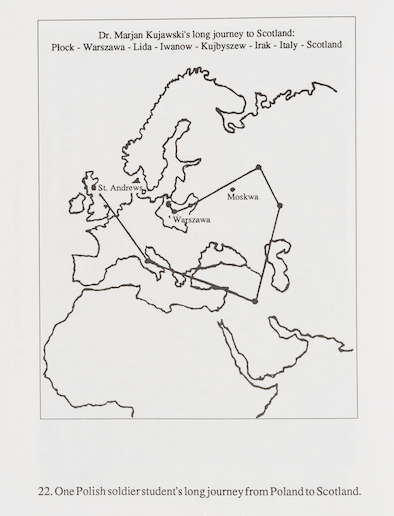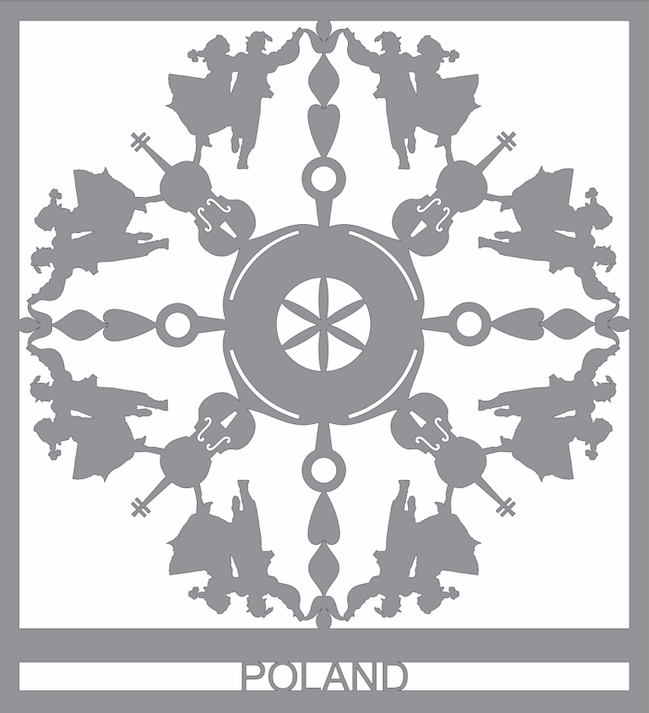From Poland to Scotland in the wake of WWII

Forced migration is often visualised through a wide-angle lens or a bird’s-eye view. With so many people displaced around the world, we often chart migration movements via statistics and maps, while national and international strategies are set out in sweeping political statements which inevitably approach the so-called ‘refugee crisis’ as a ‘global challenge’ rather than as millions of personal tragedies. Aerial shots of refugee camps, panning footage of crowds at train stations, photographs of long queues at border crossings: these can help to convey the sheer numbers of people in search of somewhere safe to stay. However, they can also sweep up all migration experiences into one universalising narrative, with the diversity of individual experiences and needs getting lost from sight. Inevitably, wide-angle shots, diagrams and charts also look at forced migration from afar, potentially distancing viewers from the humans at the centre of the story.
As many contributors to our project have stressed, it is crucial that we listen to and learn from many individual migration stories, if we are to visualise forced displacement in all its complexity and develop supportive, flexible responses for people who experience it, both near and far. While many forced migrants share experiences in common, no one journey is the same as another. One aim of this website is to juxtapose a range of experiences alongside each other, which together can shed light on different aspects of displacement, forced journeying and the search for a new home. Rather than taking a bird’s-eye view, we have prioritised personal accounts, in a range of different media, making space for individual forced migrants to tell their own stories – or for their families to do so on their behalf.

As part of this work, we have commissioned artist Diana Forster to visualise her mother’s story of forced migration in a new artwork, called ‘Somewhere to Stay‘. We have done so not because we want to suggest that her family’s experience is somehow representative of all forced displacements, but because we hope that the storytelling journey that this artwork takes us on can deepen and stretch how we visualise forced migration by enabling us to walk in someone else’s shoes for a while. Following in an individual forced migrant’s footsteps can help us work our own way through the complex emotions, decisions and challenges that they have dealt with, giving us insights into how forced migration can impact ordinary people in a host of ways through a close-up encounter with one person’s lived experience.
‘Somewhere to Stay‘ takes us back in time to the Second World War, capturing one family’s experience of being forcibly displaced from Poland to Soviet Russia in 1940 – and their long journey from there over the following years to find shelter, security and a new place to call home. In exploring a forced migration that took place eight years ago, we can examine how it played out over multiple decades and generations; history can be a valuable counter-weight to the often short-term visualising that dominates political debate. As well as offering insights into what forced migration can involve, this artwork sheds new light on conflict and its impacts. In narrating events triggered by the Second World War that are not part of the dominant historical narrative, it challenges habits of visualising that seemingly familiar conflict. And the journey it takes us on also prompts us to think about the long legacy of all wars, past and present. The ripple effects of this particular historic forced migration, from Poland to Scotland, continue to reverberate in many communities today.
You can explore Diana Forster’s new artwork here. To help contextualise it, we have drawn together some archival material held by the Imperial War Museums and the University of St Andrews which sheds more light on the experiences of Polish forced migrants during and after the Second World War. You can also listen to descendants of Polish forced migrants reflecting on their families’ experiences of displacement and home-making in the UK, and find some wider reading suggestions here. And you can explore some of the other art which Diana Forster has created in response to her mother’s story through her collection entitled ‘Such a Long Journey‘.
The journeys that forced migrants go on do not stop when they reach their physical destination: the work of adjusting, settling and belonging often lasts a lifetime, and the knock-on impacts of their displacement shape the lives of their families and communities for multiple generations. We hope that the testimonies and images we have curated in this section of our website help you to visualise the some of the long-lasting legacies of forced migration, as well as many different aspects of displacement – from rupture and loss to healing, learning, and the forging of new friendships.
Depicting Displacement
In 1940, when she was 16 years old, artist Diana Forster’s mother – Anna Sokulska Forster – was deported from her family home in eastern Poland (now Ukraine) and transported to a Soviet labour camp in Arkhangelsk. So began a long journey of survival and ongoing displacement that would see her travel thousands of miles,… Read More
A journey into the Archives
As Diana Forster and Josef Butler explain in this interview, hundreds of thousands of people were displaced from Poland during the Second World War. They left – or were forcibly expelled – for a variety of reasons, and their journeys took them in many different directions. As a result of the changing dynamics of the… Read More
Family Histories
In a series of interviews, three descendants of Polish refugees discuss what they know of their family’s migrations during and after the Second World War – and what it was like for second- and third-generation members of the Polish exile community, growing up as both Polish and British in the wake of war and displacement. Read More


